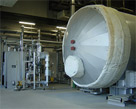Fuel Cell-centered New Energy System
- Common 5 -
We increasingly hear the term “fuel cell” in recent years. As you may know, in thermal power plants and gasoline-powered vehicles, fossil fuels are burned to obtain energy. The conventional systems emit air pollutants and a large volume of carbon dioxide, which contributes to the problem of global warming.

New Energy Plant

MCFC (installed on first floor of Common 5)
In contrast, energy technologies featuring low emissions of pollutants have been developed. These are referred to as “clean energy” technologies. Typical examples are wind and solar power generation systems. Power generation by fuel cells is one of the clean energy technologies.
At the exhibition site, a demonstration test will be conducted on new energy sources, combining fuel cell power generation and other technologies. The test will be carried out at the NEDO Pavilion located in Common 5. It is part of the “Demonstrative Project of Regional Power Grids with Various New Energies” organized by the New Energy and Industrial Technology Development Organization (NEDO). There are about five types of fuel cell systems, although all are basically alike in that hydrogen and oxygen are converted into electricity. The following three systems are being tested at the NEDO Pavilion. (Go to the demonstration plant for further information on the demonstration test.)
- Molten carbonate fuel cell (MCFC)
- Solid oxide fuel cell (SOFC)
- Phosphoric acid fuel cell (PAFC)
The fuel cell system uses raw refuse from the exhibition site for methane fermentation. Hydrogen produced from the methane is then used in fuel cells to generate electricity. The generated power is supplied to all rooms of Japan Pavilion Nagakute and to some facilities of Common 5. These facilities are expected to consume approximately 2,200 kW, two-thirds of which will be supplied by the fuel cell power generation system. As you look down from the Global Loop near the West Gate, you will see a facility resembling a chemical plant beside the Common 5 building. This is the New Energy Plant, operating primarily on fuel cell power generation. In addition to the fuel cell power generation equipment, the plant contains a methane fermentation system for fuel production, high-temperature gasification system (to gasify woody materials at high temperature), a NaS battery energy storage system to store generated electricity, and the like.
Compared with power generation by burning fossil fuels, fuel cell power generation is highly efficient, produces low noise/vibration, and emits only a small amount of carbon dioxide and other chemicals. It is an environmentally friendly technology of the near future.
Other fuel cell power generation tests will also be conducted to partially supply the power needs of pavilions other than Common 5. It is worth visiting the site and realizing in what way power generation will develop in the future.
Fuel Cell
What do you picture as the image of a battery?
What most of you picture may probably be a cylindrical battery, such as in a flashlight or TV remote control. Batteries are also used in motor vehicles. There are roughly two types of batteries commonly used in the familiar pieces of equipment around us.
- Primary battery: non-rechargeable single-use battery (including manganese and alkali batteries)
- Secondary battery: rechargeable battery (including lead-acid storage and nickel-metal hydride batteries)
Easy to handle, these items are used commonly in daily life. In contrast, solar cells and fuel cells have come into general use relatively recently.
The following is a simple explanation of the fuel cell.
Think of the electrolysis of water, which perhaps you performed in a science class when you were in primary school. Connecting a battery to two metal plates immersed in water produces hydrogen at the cathode and oxygen at the anode. The fuel cell carries out the reverse reaction.
[Electrolysis of water]
Water + Electricity ---> Hydrogen + Oxygen
[Fuel cell]
Hydrogen + Oxygen ---> Water + Electricity
This formula means that you can obtain electricity (electric energy) from hydrogen and oxygen. Oxygen is in the air. Thus, in principle, power generation is possible if hydrogen is available. The fuel cell, needless to say, causes no environmental damage, as it emits only water.
The fuel cell is a system that produces water and electricity from hydrogen and oxygen. Unlike the primary or secondary battery, the fuel cell has no capability to store electricity. Likewise, the solar cell refers to a unit that generates electricity from light and has no capability to store electricity.
The fuel cell is expected to have practical use in a number of applications, which are categorized roughly into three areas as follows:
- Automobiles : Practical use of fuel cells has begun in some vehicles. Construction of hydrogen refueling stations is under way.(In use in Inter-venue Fuel Cell Shuttle Bus between Nagakute and Seto areas)
- Stationary type : This type is installed where power is consumed, such as a business establishment and in the home.(In use in Global House, Gas Pavilion and Wonder Circus-Electric Power Pavilion)
- Portable electronics : Mobile PCs and other applications requiring many hours of continuous operation. (In use in Hitachi Group Pavilion)
For further information on fuel cell operating principles, visit the NEDO Web site.


